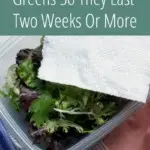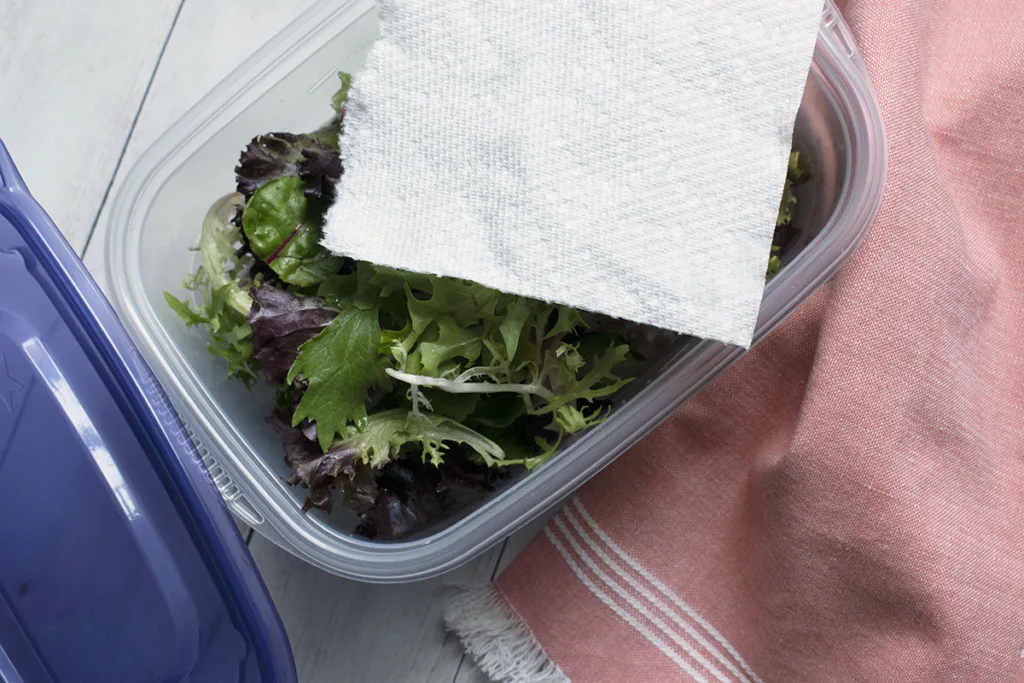
One of my favorite parts of gardening is making salads using all of the fresh vegetables that come out of my garden.
There is nothing quite so good as a sun-warmed tomato, or the spectacular crunch of a cucumber that you just picked.
But even better is the flavor and perfect crispness of freshly cut greens. Store-bought lettuces can’t compare.
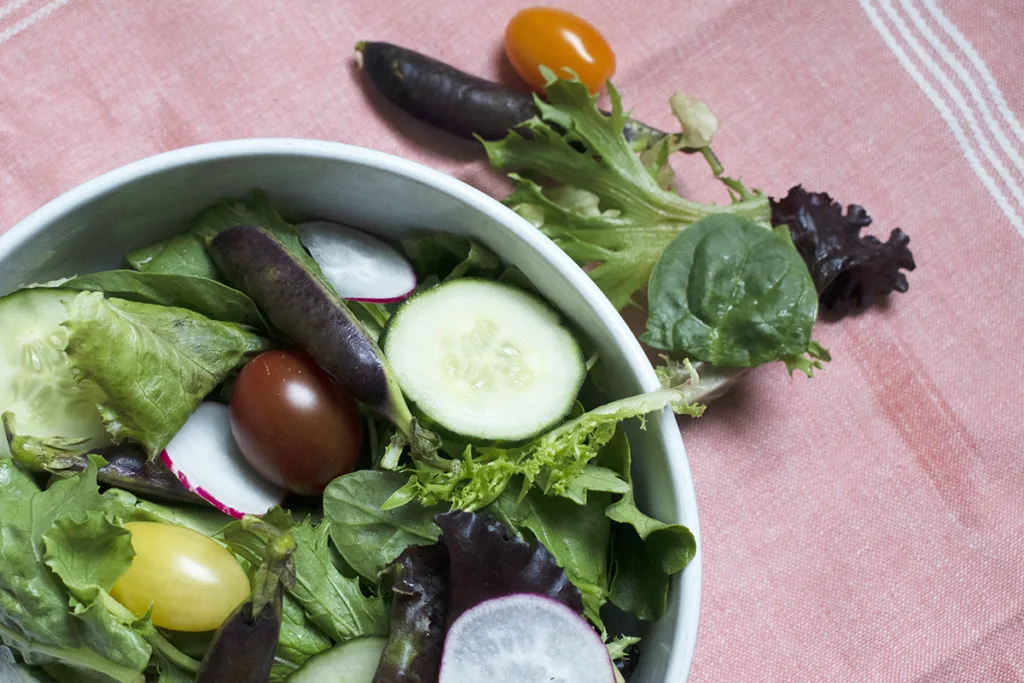
Whether you grow salad greens to be picked when they are young and tender, or you prefer something more substantial like a head of romaine or buttercrunch, you can’t beat salad greens you grew yourself.
Related Reading: How To Grow Cut & Come Again Lettuce
Often these tender plants need to be picked all at once, and once picked, they don’t last very long. And while eating salad greens from your garden is great, it’s incredibly frustrating going to your fridge to make a salad and finding wilted, brown, or even mushy greens that have gone bad.
An excellent way to avoid this from the start is by planting your salad greens over the course of a few weeks. That way, everything isn’t ready to be picked all at once.
But what do you do if it’s too late for that or you get a bumper crop when you’re harvesting? How do you keep all of those ruby red and emerald green leaves from going bad before you can eat them?
It’s all in how you prep and store your greens.
While lettuces need a little humidity, they quickly break down if they’re exposed to too much moisture. Salad greens tend to be very delicate also, so they bruise easily. If handled roughly, the leaves spoil within days.
A few years ago, I stumbled upon the best way to keep salad greens fresh and crisp for nearly two weeks at a time.
All it takes is a little extra prep work, and you’ll be amazed at how much longer your beautiful homegrown lettuces last.
This method works incredibly well for store-bought containers of salad greens too.
I used to get so mad when I would buy one and get maybe one or two salads from the package before the whole thing would go bad, and I’d end up throwing it away. What a waste of food and money!
If you’re using a store-bought prewashed salad mix, you can skip to step 3.
A note:
- You’ll want to get your greens in the fridge as soon as possible. Be sure to follow these steps as soon as you have picked your lettuces.
Step 1 – Rinse in Cold Water
Fill your sink with cold water. If your tap water doesn’t get very cold, add a few ice cubes. This will give greens a nice drink and boost their water content before you store them. It will also help to perk up greens that have started to wilt a little if you weren’t able to get to them right after picking or if it’s an especially hot day.
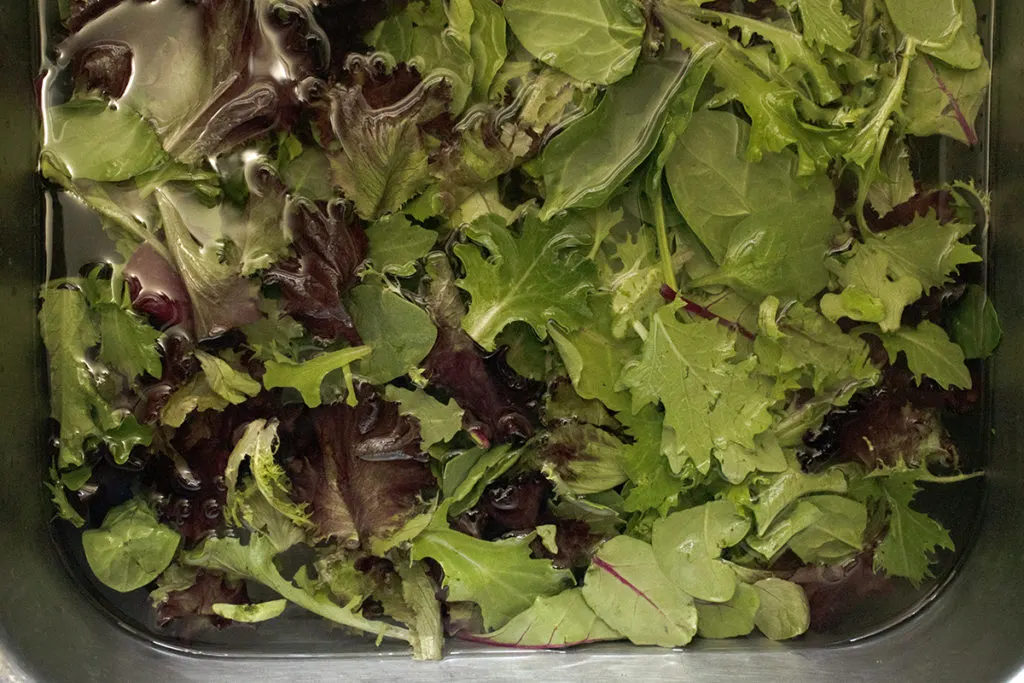
Soak your greens in cold water, swishing them gently and then letting them sit for a few minutes so that dirt and debris can settle in the bottom of the sink. Be gentle, remember bruised leaves spoil fast.
If your lettuces are especially dirty, you can repeat this step a couple more times, starting with fresh water each time. No one wants to chomp down on a bit of gritty dirt in the middle of eating a fresh garden salad.
Step 2 – Spin
I’m not big on kitchen gadgets; if it’s in my kitchen, it serves more than one purpose. But if you’re going to grow salad greens you really should have a salad spinner. It’s essential to get as much water off of the surface of your lettuces before storing them in the cold fridge.
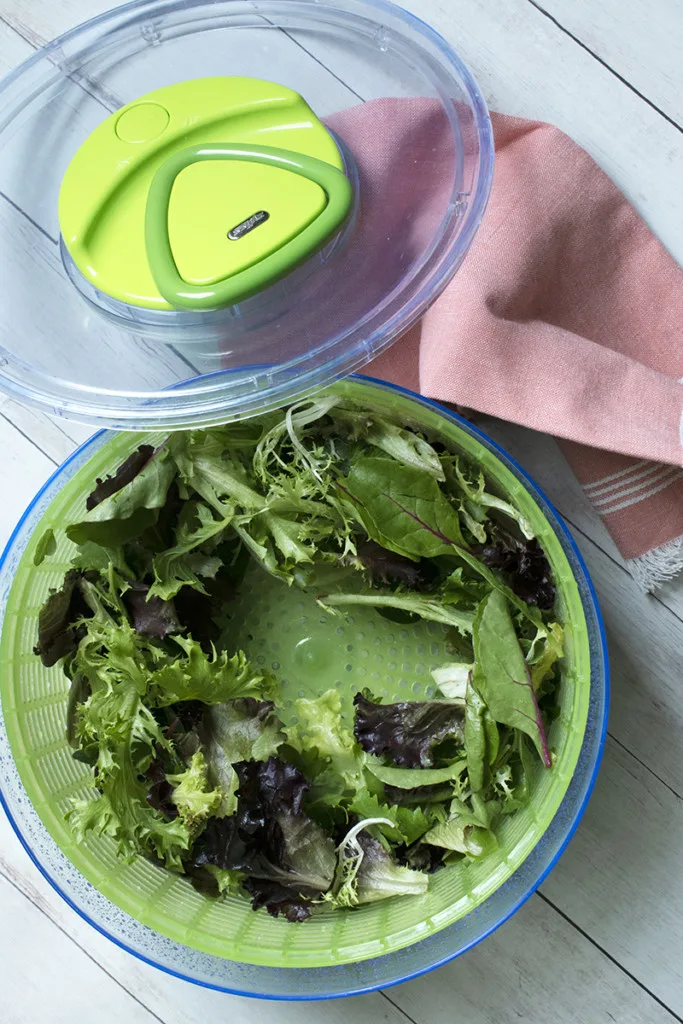
And in my experience, the best way to do that is with a quality salad spinner. I’ve had a Zyliss salad spinner for nearly two decades.
When the first one finally died last year, I immediately replaced it with the same model. This one has a different handle, and it’s green now, but it’s just as good, if not better than the last one.
Get yourself a good salad spinner; it really does make a difference.
If you don’t have a salad spinner, you can use this quick and easy method instead. You’ll want to do it outside; this is also a fun job to give to the kids. Put the freshly washed greens into a plastic grocery bag, poke several holes into the bottom of the bag with a paring knife. Now spin the grocery bag quickly in a circle above your head or to your side.
When you’re spinning your greens, do them in batches. Only fill your salad spinner basket halfway. Again, you want to be gentle, and you don’t want to crush your lettuces. Bruising leads to rotten lettuce.
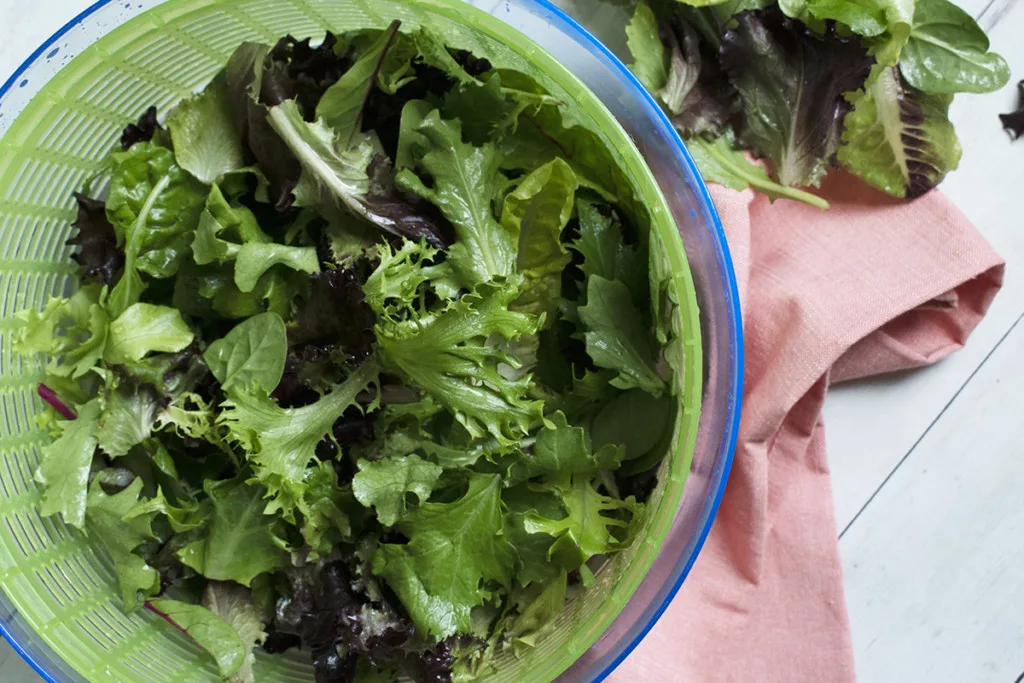
Step 3 – Gently Pack Your Greens
This step is the most important. You can either use your salad spinner or a large plastic food storage container to store your greens. If you’re using the salad spinner, be sure to drain and wipe dry the inside. You want as little moisture in there as possible. At this point, the moisture should all be inside your greens, not the container you are storing them in.

Lay a small piece of paper towel in the bottom of your container and gently place greens inside. Do NOT pack the greens down. They should lay in the container lightly compacted, but not smushed. Use several containers if you need to. Once you have all of your greens divvied up, place another piece of paper towel on top and put the lid on the container.
If you don’t use paper towels, a small piece of clean flannel or birds-eye cloth will work too. Essentially, you need an absorbent layer on the top and bottom of the container.
Step 4 – Fluff Gently and Enjoy
Whenever you make a salad, gently fluff the greens to be sure they have plenty of space and pull out any with brown spots on them. Check your paper towel and replace it if it’s too damp.
I use rectangular, two-liter sized food containers to store my greens. Every few days or whenever I make a salad, I turn the containers over – top to bottom, or bottom to top, so that the greens don’t slowly compact under their own weight.
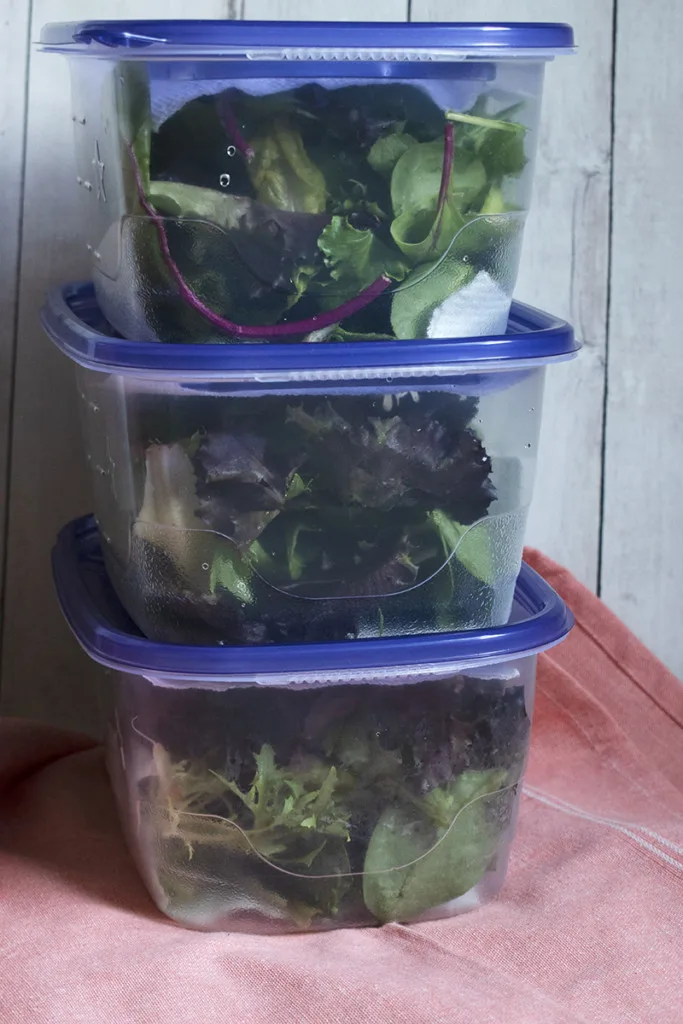
Using this method, I stopped throwing out spoiled salad greens altogether.
Gardening is hard work. Who wants to work so hard growing good food, only to have to throw it away? With a little extra care, you can eat crisp and delicious salads for weeks after picking your greens. Enjoy!
If you’re looking for even more ways to curb food waste, then you’ll definitely want to read our pantry staple guide.
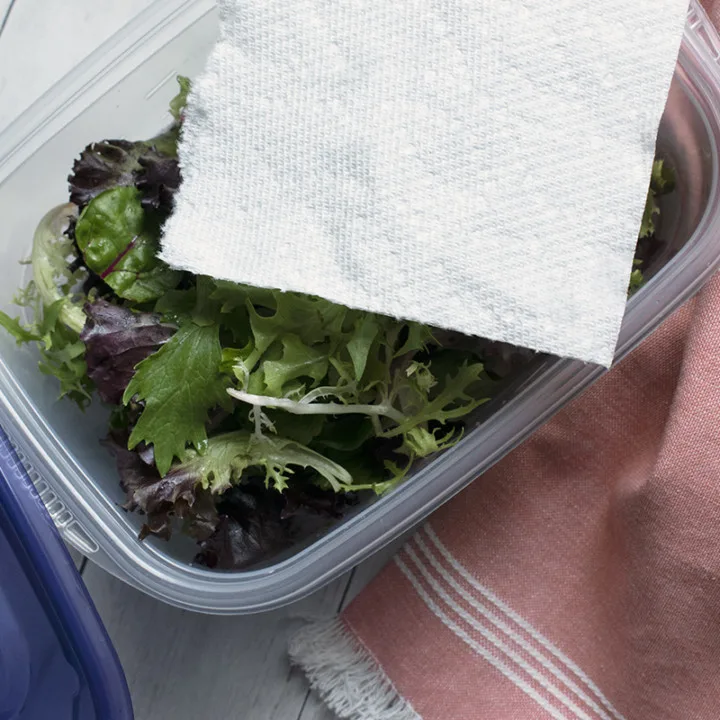
How To Store Salad Greens So They Last Two Weeks Or More
Materials
- Fresh salad greens
- Salad spinner
- Food storage container
- Paper towels
Instructions
- Soak your greens in cold water, swishing them gently and then letting them sit for a few minutes so that dirt and debris can settle in the bottom of the sink.
- Fill your salad spinner no more than half way and spin your lettuce dry.
- Lay a small piece of paper towel in the bottom of your container and gently place greens inside. Do NOT pack the greens down. Once you have all of your greens divvied up, place another piece of paper towel on top and put the lid on the container.
- Whenever you make a salad, gently fluff the greens to be sure they have plenty of space and pull out any with brown spots on them. Check your paper towel and replace it if it’s too damp.

Get the famous Rural Sprout newsletter delivered to your inbox.
Including Sunday musings from our editor, Tracey, as well as “What’s Up Wednesday” our roundup of what’s in season and new article updates and alerts.


